Searching for diamonds in the cosmic haystack
An AFSIG Article by Paul Trittenbach
When I was young—between the ages of 8-18—I used to enjoy fishing. No, I’m not going to tell you about the one that got away, because they all did. I practiced catch and release. I considered myself to be a sport fisherman. I never acquired a taste for fish, so I always let them go. I enjoyed spending many hours reeling in a feisty trout or wrestling with a Large Mouth Bass. That was until I discovered that fish have numerous nerves in their mouths and every time I caught one I was inflicting serious pain on it for no worthwhile reason at all. After that, I could no longer consider myself a sport.
I never cared if I caught a fish. Sometimes I would spend time by a stream or a pond increasing my collection of reptiles and amphibians. Sometimes I would just explore the area in the spirit of Thoreau—learning from nature by watching nature. Sometimes I would read a book. Quite often I would never cast the line, but, instead, I would sit there pondering life, the universe, etc. At times I just sat there, simply without a care in the world. It was a good way to be by myself, immersed in a universe of thoughts. “Spoil the child and spare the rod,” if you’ll excuse the pun.
About the same time, around the age of eight years old, I received my first telescope. It was a four-inch Newtonian telescope on a manually operated German Equatorial Mount. The telescope was sold by Sears but made by Bausch & Lomb Corporation. If I had that telescope today I would probably be repulsed by the quality of its optics. However, when you’re a child, the ability to see details on the moon or objects in deep space is more important than the specifications of the telescope you’re using. I loved that telescope until I got into high school and set myself to the task of purchasing a telescope blank from Edmund Scientific and grinding my own mirror.
I had always been an enthusiast of nature. My very earliest recollections were memories of collecting rocks wherever I went, and taking them home to examine them under a magnifying glass. With every specimen, I ran to the family’s encyclopedias — yes you may remember what those are — to discover as much as I could about my minerals. In the same year a next-door neighbor gave me a microscope he had used in high school. My first look at a drop of water had changed my life.
My first love was with biology. I had a consuming fascination with living things; their construction, diversity and function both as individuals and as members of an ecosystem. I owned a copy of Hunting With the Microscope, an excellent book for amateur enthusiasts, and today it is a collector’s item. I spent a lot of time examining specimens and slides under my microscope. I also performed my first dissections in the fourth grade — using guidebooks and specimens purchased at a local hobby shop.
At the same time my interest in astronomy grew. As with most amateurs, my first observations were of the moon, Saturn and the Great Orion Nebula (M42). I remember how disappointed I was with my first observations of M42. Through my telescope, the nebula was not the gorgeous pastel colors I had seen in photographs in the encyclopedia. It was black and white. This disappointment had turned into a learning experience about how the human eye works. Saturn, of course, had captivated me, as I am sure it does so many amateurs when they see it for the first time.
I took the moon for granted, as I’m sure most amateurs do! I think it was because it was always there and so easy to see, so most of us never give it a second thought. Even when I participate in community outreach, the majority of star parties are held around the time of the new moon. It seems odd to me now, because the moon is such an easy target to find that I would think it would make an outstanding incentive for people to become involved in astronomy. In addition, the moon possesses no atmosphere to block our view of it, so we can always get highly detailed views of lunar structures. And last, the moon is a fossil of our early solar system and our planet. It has so much to teach us and there are so many reasons to continue exploring it.
The night sky is a pond—more appropriately a cosmic ocean— filled with many species to fish. I cast my telescope into its waters in the hope of reeling in an interesting catch. I make it sound a lot like reeling in a feisty trout or aggressive bass but in this pond there is always a catch—a really big catch! Generally, new amateur astronomers tend to go after the most obvious fish — targets like Saturn and the Orion nebula. It takes a little time, and involves a learning curve to find astronomical objects and become familiar with the diverse species and locations of them in the cosmic pond.
Once in a while an amateur astronomer may turn a pair of binoculars to M45, the Pleiades, and be surprised at how many stars he sees. If you are like me, you heard the story of the Pleiades as the Seven Sisters — all too many novices told you that the most stars visible to the unaided eye were seven — and hence the nickname. Until I developed an interest in astronomy, I carried that explanation with me. The name refers to the fact that seven of the nine of the brightest stars were named after the Seven Sisters of Greek mythology. In reality, from a good dark location, people have seen up to 14 stars with their unaided eyes—in this cluster of 1000 members. You will never capture all those stars in a pair of binoculars, or even a good telescope. We amateurs do not have the equipment necessary to survey all the stars in an open cluster such M45. However, we do have the quality and apertures of equipment to be able to survey all of the brighter stars and the nebulosity in which M45 swims.
My first experience viewing the Pleiades through a pair of binoculars was awesome. From the small town I grew up in, seven stars were visible to the unaided eye. I was blown away by how many stars I saw. You could even see some nebulosity surrounding them. Until that time, I had never noticed that the obvious things, the things that we take for granted, can be so amazing. I think that’s one of the reasons I regret not having spent more time studying the moon. Now, when I participate in star parties I make it a habit to show those objects that first enchanted me — in part because they are easy to find, even from urban areas, and because they demonstrate what is available to every individual in our night sky. They also never fail to impress a first time crowd.
The revelation of this catch is that there is far more than meets the eye. The unaided eye can inspire us with breathtaking wide-angle views of the cosmos. We see the Milky Way swim overhead and can be awed by the contrast between the dense lanes of stars and the dark nebulosity that squirms its way through the middle of this band. There are numerous other objects available to our unaided eye.
The unaided eye will be able to see man-made satellites as they pass overhead in all directions around our planet. We can also see meteors as they enter the sky and present a fiery show on their earthward plummet. We are able to see planets, albeit they will appear as star-like objects that move against the background of the celestial sphere — wanderers, as their name infers. Occasionally we may catch the space station, an eclipse, the green flash of the sunset, or in special cases the aurora borealis. At times we may be fortunate enough to catch a hairy star as it falls toward our sun.
Comet 45P/ Hond-Mrkos-Pajuskova (45P) will be skirting along the border of Leo and Leo minor as March begins. This comet has already made its closest pass with Earth on February 11, but will still show up in a small telescope on March 2. The new moon arrives a few days before that, at the end of February. So prime viewing time for this comet is going to be early evening between the few remaining days of February and the first few days of March. By March 5, the moon is already in first quarter and its bright beam may obscure the comet lying to the East.
Comet 45P is a short period comet from the orbit around Jupiter. This visitor returns every 5.25 years. This year it was known as the New Year’s Eve comet, approaching Earth to within 7.4 million miles and presenting itself as a spectacular binocular target. By now, it has moved off and is waning at a magnitude of around 10.0.
While I was still in high school, Pioneer 10 became the first man-made probe to reach Jupiter. At that time, Jupiter was known to have only four moons — the Galilean moons. Within a few years that number had jumped to 15. Because of Jupiter’s primordial gases there was a great deal of conjecture about the possibility of life on the planet. Even in his book Cosmos, Carl Sagan had speculated on the possibility of life on that world. Sagan’s book had conjectured that life forms, from protists to metazoans, might actually exist within the clouds of Jupiter. Today, I don’t think any scientists would support this hypothesis.
At 1,300 times the volume of Earth and more than twice the volume of all the other planets combined, Jupiter is the King of the planets. Located 450 million miles from the sun, Jupiter is one of four gas giants known in our solar system (Not considering the current theoretical planet nine). Although these planets dwarf the inner, rocky planets in size, they are composed primarily of basic gases and their overall density is less than that of Earth. Saturn, for example, possesses such a low density that it would float on a lake, if one large enough existed.
Jupiter is composed primarily of hydrogen and helium and a few primordial gases, such as methane and ammonia. These gases react with sunlight to create the multicolored bands in Jupiter’s atmosphere. Until analysis from the current Juno mission, present data suggests that Jupiter possesses no solid body at its core, but rather a liquid metal core of hydrogen. This liquid core demonstrates how thick and crushing the planet’s atmosphere is and that no human or machine could ever survive a plunge into it depths. To understand Jupiter, it becomes necessary for planetary scientists to probe the atmosphere with radar, gravitational analysis experiments and invisible wavelengths of light.
Jupiter rotates on its axis once every 9 hours and 52 minutes. It completes one revolution around the sun every 11.86 Earth years. Its major feature is the Great Red Spot, a giant swirling cyclone that has been known to exist since Galileo’s time, 400 years ago. The cyclone is three times the diameter of Earth! Observations over the past 30 years have demonstrated that the Great Red Spot is diminishing in size and color. However, new storms have appeared in Jupiter’s atmosphere during the same period.
Galileo was the first human to train a telescope on Jupiter in the year 1610. He discovered that it was another world within our solar system. He discovered four moons, known as the Galilean moons, and by observing them orbiting Jupiter he was able to prove the Copernican Heliocentric model of the solar system. He also was the first human to view the Great Red Spot. The four moons visible in our telescopes are the original moons discovered by Galileo and named in his honor.
Jupiter has 67 known moons, 54 possess names. Two of the Galilean moons have come under intense study by astrobiologists for their potential to harbor life. Europa and Ganymede possess the necessary ingredients for microbial life. Both moons are ice covered worlds that harbor saltwater oceans beneath their surface. Tidal forces and Jupiter’s magnetic field keep the moon’s cores active. Those tidal forces flex the cores to generate heat beneath the ice covered surface and mix the nutrients and chemical ingredients necessary for life. Crustal fractures in the surface allow the saltwater to be transported from the ocean below and create water plumes that contain the signatures of organic materials.
The Galilean moon of IO is the second most active body in the solar system. Upon the discovery of volcanoes, planetary scientists were stunned because they previously believed that worlds so distant and small would possess cores that have cooled too quickly to sustain any thermal activity. Tidal flexing between the planet and the outer moons of Europa, Ganymede and Callisto keep IO’s core active and generate volcanoes that spew plumes of sulfur up to 300 miles into space. Europa’s organic material is believed to be a composition of sulfurous compounds sprayed onto its surface by nearby IO.
It should be no surprise that Jupiter also possesses the largest magnetosphere of any planet in our solar system. This protective field extends 2 million miles sunward and 600,000 miles in the direction of Saturn’s orbit. This enormous magnetic field is so intense that the instruments of planetary probes would be fried if they remain in its proximity for too long. The current Juno probe to study Jupiter varies its orbits to swing closer and further away from the planet as it makes it studies. A heavy shielding of instrumentation and unique orbital geometries allow probes such as Juno to remain alive as they weave in and out to examine Jupiter and its moons.
Jupiter also possesses a faint, delicate ring system composed of dust. Although Galileo was the first to view the magnificent rings of Saturn in 1610, it was not until 1979 that Jupiter’s rings were seen. NASA’s Voyager 1 probe viewed Jupiter on its outward bound journey from the planet. As Voyager 1 looked back, it snapped an image of the planet eclipsing the sun and the faint 2 mile thick ring system was seen for the first time. The rings appear to be composed of ejecta from asteroid impacts with the inner moons. They are held in place by the four moons: Amalthea, Thebe, Adrastea and Metis. It wasn’t until recently that this ring system was viewed by both Earth-based telescopes and the Hubble Space Telescope.
Anything beyond the realm of our solar system constitutes deep sea fishing. This is deep space astronomy and it is populated with species as diverse and bizarre as the benthic fish of the deep ocean trenches. Here we can find species that are invisible and hidden from view, like the translucent species of fishes in the deepwater trenches. Here we find species that feed on the energy of others. Here we can find creatures that defy the imagination. The enormous powers of creation and destruction are found in these depths.
If you really want to turn on Dancing With The Stars, then you have to select a fine binary system like Algieba. Like all binary systems, Algieba dances to the music of the cosmos in a waltz that has played out for 13.8 billion years! Located in the constellation Leo, the lion, it is one of the most spectacular binary stars of winter. The two stars of this binary whirl around a common invisible center of mass over a period of 500-600 years.
Algieba (Gamma Leonis) is the second brightest star in Leo, after Regulus. This system comprises two orange giants. It is located 130 light years away, making it a celestial neighbor and an easy target. The primary star shines at magnitude 2.4 and its companion shines at 3.4. This binary star is moving through the galaxy at a velocity of 143,844.5 mph. As it hurls through the interstellar medium it creates a bow shock—similar to a boat moving through water.
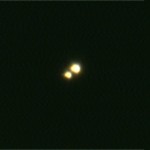
Algieba’s main component is at least 180x the luminosity of the sun and 23x its diameter. Its companion star is at least 50x more luminous than the sun and 10x its diameter. Both stars are separated by 170 AU, so they are easy to split in a pair of binoculars or small telescope. Unlike the super red giant Betelgeuse, these stars are too low in mass to produce a supernova explosion and nebula similar to M42. Instead, in a last gasp of breath they will shed their outer layers to leave white dwarfs at their center — a star of carbon and oxygen about the size of our earth. The monuments to their deaths will be radiant, short-lived nebulae known as Planetary Nebulas (PN).
Located 1400 light years away in the constellation Hydra is the planetary nebula NGC 3242, the Ghost of Jupiter/Eye Nebula. Planetary nebulas are emission nebulas, formed when stars similar to or lower in mass than our sun exhaust their hydrogen fuel and are no longer able to sustain thermonuclear fusion. Instead of dying in a cataclysmic explosion to create reflection and emission nebulae, such as M42 in Orion, their matter rebounds off their stellar cores and into space as prismatic stellar clouds — a planetary nebula is formed.
Of the 1,100 planetary nebulas in the Milky Way no two are exactly the same shape. Most are classified as elliptical or bipolar, with lobes of gas protruding from opposite sides of the white dwarf that drives them. Less than 20% of the known planetary nebulas have a spherical shape. There are different theories for why the shapes occur, but the actual process of their creation is a source of continuous investigation. The most accepted theory for the variety of shapes is that they are driven by the magnetic fields of the stars at their center. Depending upon the angles from which they are viewed, some of these clouds take on the shapes of rainbow colored rings or spirals — such as the Ring Nebula (M57) in the constellation Lyra or the Helix Nebula (NGC 7293) in the constellation Aquarius — while others take on balloon-shaped lobes like those found in the Dumbbell Nebula (M27) in the constellation Velpecula.
The gases of the nebula are illuminated by the ultraviolet light of the hot white dwarf at its center. Unlike the emission and reflection nebulae, such as the Trifid Nebula in Sagittarius, the white dwarfs driving planetary nebulas erode their clouds away in as little as 10,000 years. Regardless of this short lifespan, NGC 3242 will be around long enough for us to enjoy. This is a stunning sapphire blue nebula that can be easily seen through a pair of binoculars or a small telescope. However, larger apertures will reveal more detail in NGC 3242.
Although the name Planetary Nebula implies “planet” it is a misnomer. According to legend, the term planetary nebula was coined in the 18th century by Sir William Herschel, who upon viewing his first planetary nebula confused it with Uranus — also one of his discoveries. The Ghost of Jupiter Nebula has absolutely nothing to do with the planet Jupiter.
Last month I devoted an entire article to open star clusters. This month I wanted choose one of the brightest and finest star clusters of the winter sky. Located 33,900 light years away, in the constellation of Canes Venatici, is the globular cluster Messier 3 (M3 or NGC 5272). Globular star clusters are dense associations of stars that are gravitationally bound together and traveling independently of the rest of the stars in our galaxy. These clusters are nearly as old as the universe itself. Where an open cluster consists of stars that are separated enough to resolve individual components in a telescope, a globular cluster is so dense that the core cannot be resolved into the individual components, even in professional telescopes.
Globular clusters can consist of hundreds of thousands to 1 million stars. These clusters reside in the halo of our galaxy, as opposed to the open clusters which reside in the spiral arms. Messier 3 consists of 500,000 members spread across the diameter of 220 light years. The members of this cluster are estimated to be 12 billion years in age. To put that into perspective, our sun is estimated to be 4.5 billion years old. Astronomers believe that star clusters are necessary for the production of galaxies.
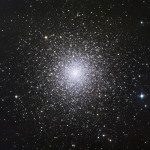
NASA image/ Teuwen
M3 shines in a magnitude of 6.2 and is easily visible through a pair of binoculars. It will resolve into a bright central core that appears to resemble a snowball in space, a large aperture telescope will resolve more components. Because of its age, the population of M3 is predominately orange-red giant stars, that have burned through their hydrogen fuel and moved off the main sequence. However, there are several blue giants infused among this retirement community. Blue stars are young stars that cannot have developed within the same nebula that birthed the cluster. But when two stars merge their combined mass may form stars known as Blue Stragglers.These are the stars found in M3.
In Pennsylvania, where was born and lived for half my life, the night sky was awash with sky glow from the metropolitan areas. Escaping to the rural areas wasn’t much of a respite from the glare of the cities. The sky was gray and never achieved the black that I have experienced in the West. When I purchased my home on the Southeast side of Tucson, the night sky was very dark in comparison to the adjoining city. There were no shopping centers, very few schools and no grocery stores. The trade off of traveling a short distance for essentials was worth the price in exchange for the bounty of the cosmos available from my doorstep. With the cooperation of neighbors, porch lights were quelled and observing could commence. The time saved in traveling out of town to observe was gained as extra time under the stars.
It didn’t take much time for the city to encroach upon my pond. Within a few years, strip malls, grocery stores and schools sprang up like weeds on what once was a well manicured and verdant lawn. More and more, the city was moving in and the stars were moving out. Star clusters, galaxies and nebulas that were once very visible were now diluted by the sky glow of the surrounding businesses. UHC and light pollution filters helped to manage some of the light reflected from the pavement. But the damage was done, my pond had become polluted!
Over the years I have sought out better fishing holes—areas where the pond is less polluted. Even areas designated as dark protected sites are experiencing the crunch of encroaching cities. The club maintains a premier dark site near the Chiricahua National Monument (CAC). It is an excellent respite from the sky glow of the city and offers sensational fishing of the nocturnal pond. Recent studies have reported that 2/3 of the population of Earth cannot see the Milky Way from their locations. My hope is that city leaders will become more aware of light pollution and its ill effects upon human health and the health of plants and animals in the environment. Perhaps, one day, we will again be able to fish the night sky from all locations on Earth.
5,000 light years away in the constellation Monoceros lies the Rosette Nebula (Caldwell 49, NGC 2237). This is a faint but beautiful nebula which glows in the HII region at a magnitude of 9.0. The nebula is part of a larger region of nebulosity that includes several New General Catalog members: NGC 2238, 2239, 2244, 2246 and 2237 – which is the designation for the entire nebula region. Although the nebula can be viewed through a small aperture, you will want to employ a Hydrogen Beta (H-Beta) filter and a large aperture to tease out its details.
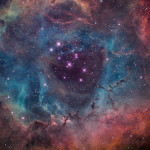
Caldwell 49 spans a diameter of 100 light years. This emission nebula is the nursery to 2500 type O stars. Most of the stars are enshrouded within the dense molecular cloud that comprises the nebula. Similar to the Eagle Nebula, optical data from the Digital Sky Survey reveals pillars (of creation) in which the young stars are born. The total estimated mass for the nebula is 10,000 solar masses.
Embedded in the nebula is a fine open cluster: NGC 2244 (Caldwell 50). The young, blue stars of this open cluster formed about 4 million years ago within NGC 2237. Their stellar winds are eroding away the nebula. It is the ultraviolet light from the young stars of this cluster that causes the gases of nebula to ionize and glow. The cluster is an exquisite collection of stars glowing at a magnitude of 4.4. It is easily visible through binoculars. However, NGC 2237 will not show up in binoculars.
The gas and dust molecular clouds take on the shape of a blossom, with the center area cleared out by erosion from the stellar winds of NGC 2244. The complex of nebulosity, consisting of the aforementioned New General Catalog members is a writhing mass of gas and dust lanes of varying degrees of illumination. Using the aforementioned H-beta filter or a UHC (ultrahigh contrast) filter will help to tease out details when viewed from a dark site such as the CAC facility. Even if you find that you are unable to see the nebula, the fine open cluster of NGC 2244 will be a treat unto itself.
Casting into the deep again, I seek out species of a different type and residing at greater depths. In the ocean’s abysses there are strange denizens that seem more like visitors from an alien planet than members of the same DNA heritage as us. It is as if the trenches opened up and released creatures from an Arthur Conan Doyle novel. Here, Winteria Telescopa (an excellent species for an astronomy article), a bug-eyed, jagged toothed predator, that looks like it swallowed a balloon, plies the waters. These same depths are shared by Bathynomus giganteus, an isopod and relative to the lobster that resembles a monster from the movie Deep Star Six.
In these depths, where the sun doesn’t even dare to tread, translucent Angler fishes hunt for prey using lures that resemble worms and attract their quarry with bioluminescence. The Sloane’s Viperfish possesses a jaw as big as his body, lined with long, pointy teeth that protrude well beyond his mandibles. This fish looks like the Sabertooth Cat of the abyss. Frill Sharks are predators near the top of the food chain at these depths. Their appearance resembles a flattened eel more than any shark that most of us would be familiar with. Perhaps this is an evolutionary adaptation to the intense pressures of the deep ocean. The list of weird and unbelievable creatures goes on.
Deep space, too, is filled with denizens that seem more like something out of a science fiction movie—too strange to be believable. There are magnetars and blazars, pulsars and neutron stars. There are giant stars and super giant stars—stars that turned into Frankensteins at the end stages of life, then erupt in horrific conflagrations that create supernovas. There are stars that cannibalize their companions before their gluttonous appetites cost them their lives in similar explosions. There are stars of carbon — blood red diamonds of the night. There are Active Galactic Nuclei (AGNs) that cause the stars of their immediate neighborhood to go into frenzied orbits, while they consume their energy. They are the vampires of the cosmos.
There are planets that wander interstellar space without a star to call their own. They are cold, frozen bodies, perhaps harboring remnants of lifeforms, frozen in time. There are super Jupiter gas giants, in orbit so close to their stars that their atmospheres are evaporating into interstellar space—being consumed by the mother that bore them. Other earths must exist, with bounties of life flourishing upon their faces. There are beautiful blossoms—the nebulas—products of the enormous explosions of the supernovas.
These, too, and all the other denizens of the deep space realm seem like creatures from an Arthur Conan Doyle novel. They are dinosaurs of the ancient universe, revealed to us by the speed limit imposed upon light. These beasts from the bowels of the universe demonstrate to us the enormous powers of creation and destruction that are the laws of the cosmos. They are the masters and creators in our universe. We can fear and simultaneously admire them.
In the constellation Leo, at a distance of approximately 30 million light years, lie three galaxies collectively known as the Leo Triplett, also known as the M66 group. This grouping of three large spiral galaxies are generally shown together at star parties as both a crowdpleaser and a wow factor. The triplett consists of the galaxies NGC 3628, M66 and M65. In the grouping, the three galaxies are tilted at different angles to the viewer, presenting the deceptive view that the galaxies may not all be large spirals. NGC 3628 is seen edge on. Obscuring dust lanes wrap across the plane of this galaxy, like a belt.
M65 and M66 are both tilted toward the viewer at angles that make their disks more obvious. Gravitational interactions between these galaxies have warped their disks and stretched out their spiral arms. In a telescopic view, the eye is unable to perceive the intricate details of the three galaxies. To view the Leo Triplett a wide-angle eyepiece is necessary. The Leo Triplett is accessible through a small aperture, such as a 4 inch telescope. The view of the three galaxies covers 500,000 light years.
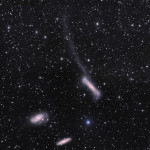
NASA Image/ Steve Mandel
Spanning a diameter of 95 light years across, M66 is the largest member of the Leo Triplett, and shines at a magnitude of 8.9. NGC 3628 and M65 shine at magnitudes 10.2. While the dust lanes of NGC 3628 are more obvious because they obscure the disk of the galaxy, M66 also possesses a thick dark lane that surrounds the outer portions of the galaxy. The gravitational interactions between these galaxies results in prodigious star formation. The title of facts from NGC 3628 spans 300,000 light years. M66 is the brightest member of the Leo Triplett.
Located 28 million miles from our galaxy in the constellation Virgo is a great spiral galaxy, Messier 104 (M104), the Sombrero Galaxy. If viewed from above, this 50 light year diameter galaxy would appear to be a spiral like our own Milky Way. But from the vantage point we have, slightly above the galactic equator, we see M104 as a large, bulbous halo of stars and gas that extends well above and below the galactic disk. From this vantage point M104 appears to be a mirrored, broad rimmed Mexican hat — and hence its name.
The Sombrero Galaxy is a member of the Virgo super cluster, the same cluster of galaxies to which our Milky Way belongs. This is a web of gravitationally bound galaxies with 2,000 known members. Sombrero Galaxy has an estimated mass equivalent to 8 billion suns and is rich and globular star clusters. There are an estimated 2,000 of them within the galaxy. The center of the galaxy is the home to a bright core of a 1 billion solar mass, supermassive black hole! In 2012 the Spitzer Space Telescope discovered that a second galaxy was embedded within M104. Galaxy mergers are not uncommon in the universe. Astronomers know that even the Milky Way is currently consuming at least two dwarf galaxies.
Until the 20th century astronomers believed that the Milky Way was the entire universe. Previous to that all patchy cloud-like structures were believed to be nebulae and part of our galaxy. In 1912 the astronomer Vesto Slipher observed M104 and hypothesized that it was moving away from our galaxy at a speed of 7000 mi./s. The enormous velocity of this nebula gave us clues that the universe was in fact much larger than our Milky Way and that separate structures existed outside of it.
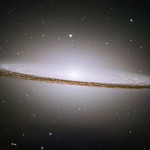
Image: Hubble Heritage Team
Before Carl Sagan introduced the world to his series Cosmos in 1980, I used to write extra credit reports for my classes in high school. By the time I reached junior high school I began to realize that the universe was one interwoven tapestry of matter and energy that created everything we know. The creatures, the leaves on the plants they sat upon, the blades of grass, trees, the rocks, the stream and everything was precipitated from the hot soup of energy of the Big Bang. As the universe cooled down and formed matter, the subatomic particles evolved into the atoms, the atoms evolved into chemicals, the chemicals evolved into compounds and many of them became animated. At least one species was successful enough to stand on two legs, look up to the sky and ask questions about what all this was and what it meant.
In the same way that the electromagnetic spectrum is a continuum of light ranging from the invisible radio through the visible to the invisible gamma radiation, all of nature is a continuum from the precipitation of energy to matter, subatomic to atomic, atomic to chemical, physical chemical to biochemical, and life. This is a simplified explanation at best, but the relationship between physical, chemical and biological is the spectrum we call the universe.
My English teacher gave me a “C” for every one of my essays. Perhaps she found the material uninteresting. Perhaps she just found it boring. My science teachers, however, enjoyed my essays and gave me lots of extra credit for my enthusiasm, interest and insight into nature. When Carl Sagan arrived on PBS, he validated my assessments. The universe is one big fabric of interlaced members, each complementing and completing the other.
It is this relationship between the physical and biological world that keeps me intrigued and staring at both ends of the universe through my telescope and microscope. As I divide my time between the microscopic and telescopic realms I also recognize the obvious macro world of the metaphyta and metazoa—the multi cellular plants and animals of our visible, everyday world. I also realize that there are microscopic worlds that can only be accessed via an electron microscope and the subatomic that is only visible through machines like the Large Hadron Collider.
There are Go-To telescopes and star guides for helping us locate the fish in the celestial pond. Likewise there are sonar fish finders and lures that guarantee a catch with every cast. Perhaps that is cheating, but no hobby today is what it was when I was young. I also doubt that anyone owns a set of encyclopedias anymore. One great thing about fishing the night sky is that when you brag about your catch, and everyone believes it’s just a fish tale, at least there are photographs to prove it.
Over the years I have sought out better fishing holes—areas where the pond is less polluted. Even areas designated as dark protected sites are experiencing the crunch of encroaching cities. The club maintains a premier dark site near the Chiricahua National Monument (CAC). It is an excellent respite from the sky glow of the city and offers sensational fishing of the nocturnal pond. Recent studies have reported that 2/3 of the population of Earth cannot see the Milky Way from their locations. My hope is that city leaders will become more aware of light pollution and its ill effects upon human health and the health of plants and animals in the environment. Perhaps, one day, we will again be able to fish the night sky from all locations on Earth.
Whenever I cast into the cosmic pond I care if I catch a fish. Sometimes I will spend the time increasing my quota of newly observed celestial objects. Sometimes I will observe the night sky with my unaided eye, lying on my back and staring up at the sky, like a walk through the woods in the fashion of Henry David Thoreau. Sometimes I will leave the telescope behind and never cast a line into the pond. There are times when I will lie beneath the sky without a care in the world — lost in a universe of thoughts. Regardless of what method I choose to fish the nocturnal pond, there is only one thing wrong: at the end of the night, regardless of the size of the catch, I always have to throw it back.


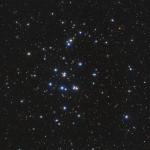
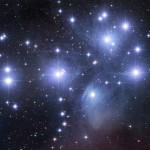
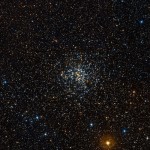
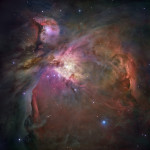
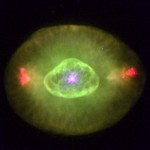
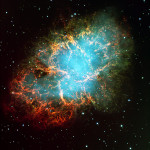
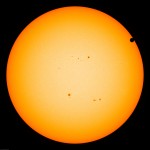
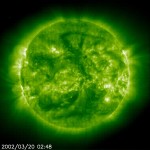
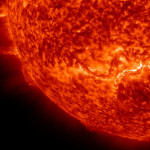
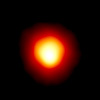
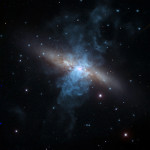
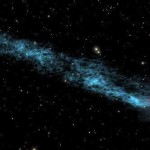
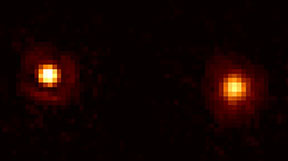
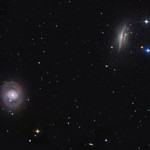
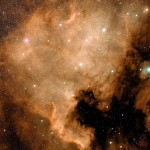
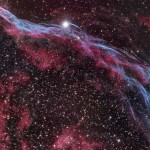
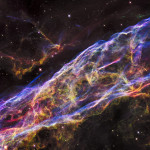
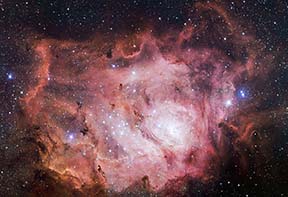
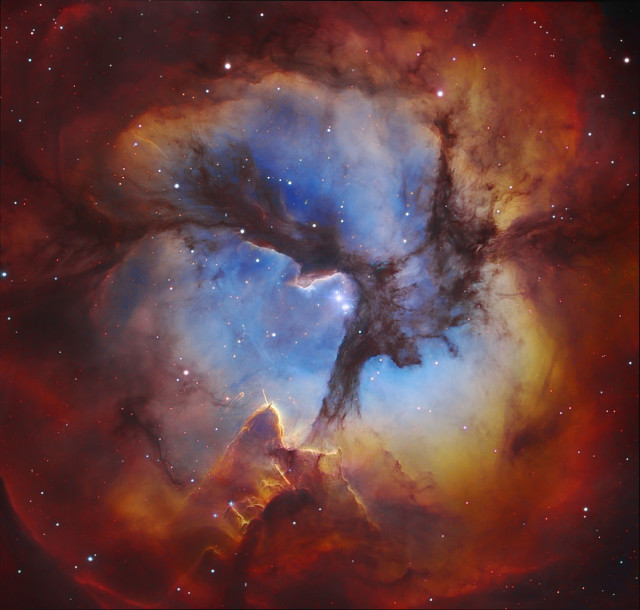
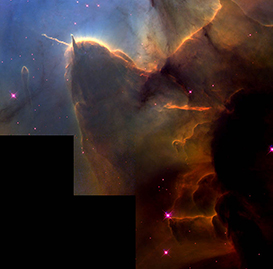
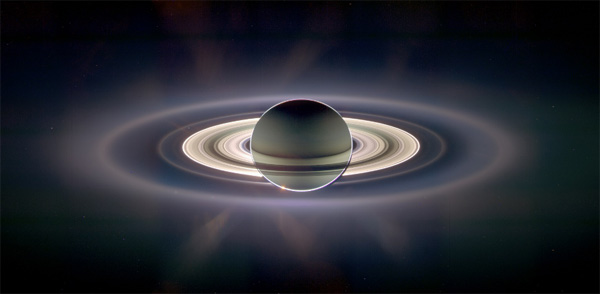
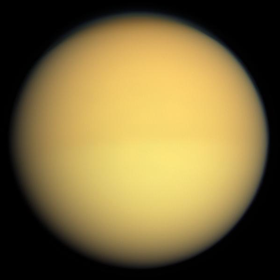 Saturn’s moon Titan was discovered by Christian Huygens in the year 1655. Giovanni Cassini followed up with the discovery of the next four moons: Iapetus, Rhea, Dione and Tethys. In 1784 William Herschel discovered Mimas and didn’t sell at this. More than 50 years had passed before the discovery of Hyperion and Phoebe. As the size and resolving capacity of telescopes increased, so too did the number of discoveries of new moons around Saturn. Additional discoveries came via robotic probes, such as the Cassini mission earlier this century.
Saturn’s moon Titan was discovered by Christian Huygens in the year 1655. Giovanni Cassini followed up with the discovery of the next four moons: Iapetus, Rhea, Dione and Tethys. In 1784 William Herschel discovered Mimas and didn’t sell at this. More than 50 years had passed before the discovery of Hyperion and Phoebe. As the size and resolving capacity of telescopes increased, so too did the number of discoveries of new moons around Saturn. Additional discoveries came via robotic probes, such as the Cassini mission earlier this century.